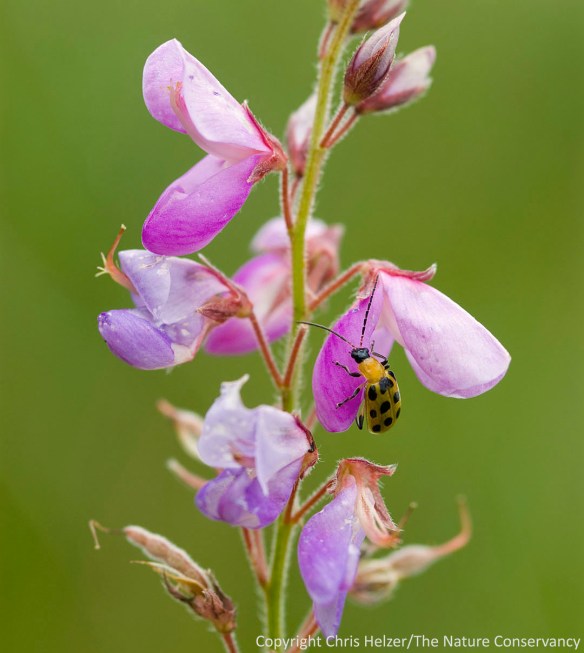As we’ve been looking for bees lately, I’ve noticed the abundance of spotted cucumber beetles (Diabrotica undecimpunctata) in our prairies. I’ve primarily noticed them because they are feeding on the pollen of flowers, and from a distance they look like a bee. I can’t count the number of times I’ve crept up to a flower to see what kind of bee is on it, only to find that it’s just another cucumber beetle…
Spotted cucumber beetle has another name that will be very familiar to farmers – southern corn rootworm. While it’s a native insect in North America, it has adapted very well to human agriculture and is now considered a pest in both crop fields (corn and other crops) and gardens (cucumbers and other cucurbits). I’m hoping some of the readers of this blog can help me answer a couple questions I have about cucumber beetles.
1. Are spotted cucumber beetles more abundant in prairies now than historically because of the prevalence of nearby crop fields?
2. Do cucumber beetles have a significant impact on any particular prairie plant species or on the overall ecology of prairies?
As far as I know, cucumber beetles are just nicely adapting to human-dominated landscapes, and while I see a lot of them, their primary impact is that they keep fooling me into thinking they’re bees…


Gosh Chris! Don’t ask us any impossible questions (i.e., your first one).
The second question is a good one (i.e., answerable, with study).
Great photography……….
Hi Chris!
You may be noticing the cucumber beetle a great deal more because of the recent deaths of millions of our native bats who specialize in eating these beetles and other crop-destroyers. White-nose syndrome is the primary cause, but several other bats known to fly out from their woodland edges at night, and across the prairies in search of insects, are endangered for other reasons such as habitat loss- an example being the Indiana Bat. Here is an important fact that illustrates what could happen if we lost only 150 bats out of a particular ecosystem:
“According to the Kentucky Department of Fish and Wildlife:
“Cucumber beetles eat spinach and corn, but their larvae, corn rootworms, can hurt corn productivity by 10 to 13 percent. It costs from $15 to $25 per acre of corn to control corn rootworms. A colony of 150 big brown bats can eat 38,000 cucumber beetles in a summer season. Their appetite prevents the cucumber beetles they eat from producing 18 million corn rootworms.”
While undeniably destructive to crops, it will be interesting to see what positive affect, if any, the native cucumber beetle may have as a prairie native pollinator.
I look forward to getting your posts. Thanks for all the hard work you put into them, and for the questions you raise, and the experiences you share.
Carrie McLaughlin
Texas Master Naturalist
Thanks Carrie,
Fortunately we’ve not (so far) documented white nose in Nebraska. Looks like it’s coming, though. I don’t think we’re seeing any more beetles than we have in the past (though that’s VERY observational, rather than data based). I just think we have a lot of them! Not that it’s bad – as you say, they surely do at least some pollination, though may also damage the flowers to an extent that negates any benefits of their pollination. Who knows? Not me!
Among bats, the only species that is demonstrated to eat a lot of beetles (indeed, semi-specializes on them). It has been shown to be affected by the white-nose fungus, but since the disease is not yet detectable in Nebraska, that is moot, for now. Moreover, this bat prefers larger prey, such as June beetles and other large scarabs, Callosoma carabids, and the similar-sized carpenter ant alates, while passing up the smaller beetles.
So yeah, we’re making a mess of things, but apparently not in the particular way you suggest, Carrie.
James – which species of bat is it that semi-specializes on beetles?
Oh my, that was an oversight, or accidental deletion, or something — Big brown bat.
I remember spotted cucumber beetles (or something that looked very like them) were such a problem in our home garden in southern Kansas in the 1940s that one of my “jobs” as a boy was to smash them, carefully, between my fingers whenever I could catch them. They are not very hard to catch, so I got pretty good at the task. We weren’t growing cucumbers, but they would also feed on several other vegetables, and flowers. We grew a lot of sweet corn, which no doubt attracted them; but I didn’t know their larvae also fed on the corn until reading it here.
Spotted or southern corn rootworm beetle’s larvae are only an issue on early planted corn grown in the southern USA. Not in Nebraska. Only the western and northern species’ larvae effect field corn, sweet corn and popcorn grown in the Great Plains and midwest. Then only on continuous corn fields, not rotated fields in Nebraska yet, for the most part. The adults do some foliar feeding early on corn at V3 to V5 stage of growth but rarely any economic damage. I don’t believe their larvae overwinter in Nebraska. The adults one sees in the spring have blown in from the south.